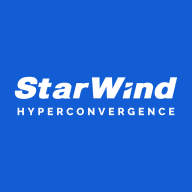

StarWind Virtual Tape Library and Azure Stack HCI are competitors in the realm of data storage and cloud solutions. StarWind shines in customer satisfaction and affordability, whereas Azure Stack HCI impresses with its advanced features, justifying a higher price tag.
Features: StarWind Virtual Tape Library offers seamless integration with existing backup solutions, advanced data de-duplication, and archiving to cloud services like AWS. Azure Stack HCI excels with high-performance computing, software-defined networking, and the ability to run Azure Kubernetes Service within the cluster.
Room for Improvement: StarWind could benefit from simplifying its technical deployment and management. Enhanced integration with more cloud providers would also be advantageous. Meanwhile, Azure Stack HCI may improve by simplifying deployment processes, reducing overall cost, and offering more personalized customer support strategies.
Ease of Deployment and Customer Service: StarWind Virtual Tape Library offers straightforward deployment and robust customer support. Azure Stack HCI's deployment is more complex due to comprehensive infrastructure, but benefits from extensive Microsoft support.
Pricing and ROI: StarWind Virtual Tape Library is cost-effective with a rapid return on investment, appealing to cost-sensitive enterprises. In contrast, Azure Stack HCI comes at a higher initial cost but offers scalability and integration benefits for significant ROI over time.


Azure Stack HCI efficiently integrates software-defined networking and Azure Kubernetes Service, offering a streamlined hybrid setup for VM management while maintaining top performance.
Azure Stack HCI enhances data center operations with high-end processors and storage, optimal Kubernetes support, and integration with Azure Arc and Azure Site Recovery. High application density in four-node configurations improves both time and infrastructure efficiency. Despite its strengths, the platform can improve in areas like software-defined networking, operational management, and simplifying deployments, which currently rely on PowerShell. Users often desire better training and integration with Microsoft Azure Portal, along with multi-cluster capabilities and storage architecture enhancements. Improvements in Hyper V virtualization are also needed to match competitors like VMware.
What are the key features of Azure Stack HCI?In sectors like government, Azure Stack HCI is crucial for running secure on-premise services with selectable Azure features to ensure data privacy. Businesses leverage the platform for VM creation, management, and monitoring through Windows Center, alongside Kubernetes production environments. Connectivity with Azure allows for smoother cloud transitions, appreciated for its dashboard manageability and substantial network capacity.
For SMB and Enterprises, who either look to get rid of backup tapes completely, or are willing to accelerate backup process and add an extra level of protection, our solution is StarWind Virtual Tape Library (VTL). It is an appliance that eliminates the need in physical tape and “pretends” to be a supported tape drive or autoloader, keeping all data on inexpensive, fast and high-capacity spinning disks.
Even with explosive data growth, StarWind VTL fits the backup into backup window by accelerating it, so the process does not overlap with production time. Optionally, it creates additional copy of backup data for better safety. It is also available in a software-only form, as part of StarWind VSAN functionality.
StarWind VTL targets those, who need to replace existing tape backup infrastructure or accelerate it if regulatory requirements prohibit replacement. In case the goal is just virtualizing tape backup or creating a stretched backup infrastructure, StarWind Tape Redirector will come in handy.
We monitor all HCI reviews to prevent fraudulent reviews and keep review quality high. We do not post reviews by company employees or direct competitors. We validate each review for authenticity via cross-reference with LinkedIn, and personal follow-up with the reviewer when necessary.